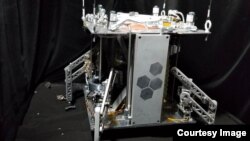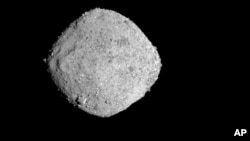The history of steam power goes all the way back to the 1700s. At the time, steam was used to power many different machines and helped fuel the Industrial Revolution.
Over the years, steam was replaced by other fuel systems to power everything from homes to cars to industrial equipment.
Now, some American scientists are developing steam power for one of today’s most highly technical activities, space exploration.
Research scientists from the University of Central Florida (UCF) and U.S.-based space company Honeybee Robotics are carrying out the project.
The scientists are developing and testing a space robot model named The World Is Not Enough, which they call WINE for short. The spacecraft is designed to travel repeatedly between space rocks called asteroids and planets throughout the solar system.
The spacecraft is designed to land on these space objects. It has tools to search for and collect water that might be below the surface. WINE can then heat the water to create steam to power the spacecraft to its next space stop. WINE is equipped to gather and use solar energy as well.
The company Honeybee Robotics built the model that the researchers recently tested. The UCF team provided a reproduction of asteroid material for the test, as well as computer modeling used to design WINE.
Phil Metzger is a planetary research scientist at UCF. Before joining the university, he spent nearly 30 years working at the National Aeronautics and Space Administration (NASA). He worked three years on the latest project, developing the technology necessary for creating a working model.
Metzger said in a statement the test was a successful demonstration of the spacecraft’s abilities. He reported it was able to dig into the simulated asteroid material and collect water. It then produced steam fuel that permitted the spacecraft to complete its own launch.
The scientists believe the technology could open up limitless space exploration. Currently, interplanetary space exploration trips must end when the spacecraft runs out of fuel.
“Each time we lose our tremendous investment in time and money that we spent building and sending the spacecraft to its target,” Metzger said. “WINE was designed to never run out of propellant so exploration will be less expensive. It also allows us to explore in a shorter amount of time, since we don’t have to wait for years as a new spacecraft travels from Earth each time.”
Metzger says WINE spacecraft could keep traveling to many different asteroids and planets. They could carry out experiments before refueling and launching to the next stop. He said such exploration activities could be carried out anywhere there is water and the right gravitational conditions.
Kris Zacny is the vice president of Honeybee Robotics. He also described the test as a great success, saying “WINE-like spacecraft have the potential to change how we explore the universe.”
WINE is linked to NASA’s Small Business Technology Transfer program that supports university and small business cooperation on space research projects.
I’m Bryan Lynn.
Bryan Lynn wrote this story for VOA Learning English, based on reports from the University of Central Florida and Honeybee Robotics. Caty Weaver was the editor.
We want to hear from you. Write to us in the Comments section, and visit our Facebook page.
________________________________________________________________
________________________________________________________________
Words in This Story
tremendous – adj. extremely good
propellant – n. fuel that causes something to move
expensive – adj. costing a lot of money
allow – v. to permit
potential – n. an ability that has not yet been developed












